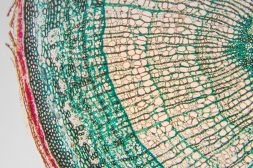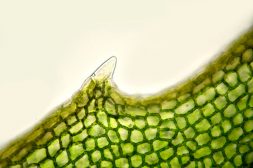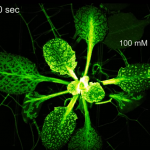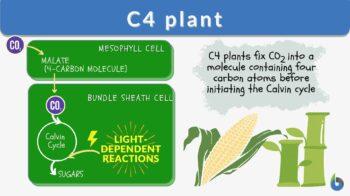
C4 plant
n., plural: C4 plants
Definition: A plant that utilizes the C4 carbon fixation pathway
Table of Contents
Carbon fixation is a process of taking carbon dioxide in order to synthesize sugar, such as glucose. Thus, carbon dioxide is a vital step in photosynthesis, together with photolysis (light reactions) and Calvin Cycle (dark reactions). In general, plants are grouped based on the mechanism used for fixing carbon. These plant groups are C3, C4, and CAM plants. C3 plants utilize the C3 pathway (the initial step of the Calvin-Benson Cycle), C4 plants employ the C4 pathway, and CAM plants use the Crassulacean acid metabolism pathway. Let us know more about them, especially the C4 plants!
C4 Plants Definition
A C4 plant fixes CO2 into a molecule containing four carbon atoms before initiating the Calvin-Benson cycle of photosynthesis. The C4 pathway is also known as the Hatch–Slack pathway. It is one of three photosynthetic pathways of carbon fixation in plants that have been discovered. The C4 cycle was discovered by Marshall Davidson Hatch and Charles Roger Slack in the 1960s, thus, the name. According to this, some plants, when provided with 14CO2, aggregate the 14C label into four-carbon molecules first.
What is a C4 plant? In the mesophyll cell, CO2 is coupled to the primary carbon dioxide acceptor in C4 plants phosphoenolpyruvate, resulting in the creation of a four-carbon molecule (oxaloacetate), which is then shuttled to the bundle sheath cell, where it is decarboxylated to free carbon dioxide for carbon assimilation in the C3 pathway.
Other types: C3 plants and CAM plant
The Calvin cycle begins with the fixation of carbon dioxide by RuBisCO, and plants that rely only on this “conventional” approach are referred to as C3 plants, after the three-carbon molecule (3-PGA) generated as a consequence of the process. Rice, wheat, soybeans, and all trees are classed as C3 plants, accounting for nearly 85 % of all plant species in the world.
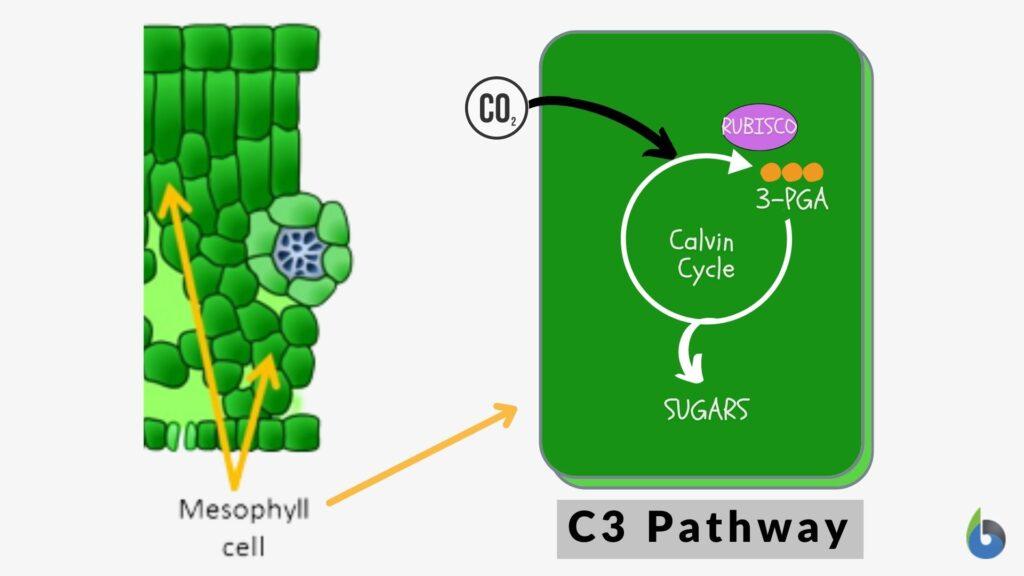
Cacti and pineapples, for example, employ the crassulacean acid metabolism (CAM) photosynthesis pathway to save water and reduce photorespiration while growing in dry areas. The name comes from the Crassulaceae family of plants, which is the first group of plants when scientists discovered the pathway. (Academy, 2022)
Watch this vid to learn the different anatomical and physiological properties of C3, C4, and CAM plants
A C4 plant is a plant that utilizes the C4 carbon fixation pathway. C4 plants are characterized by the following:
- Going through the C4 carbon fixation pathway. This pathway is when the CO2 is first bound to phosphoenolpyruvate in the mesophyll cell. Then, the process proceeds to the Calvin Cycle. (Thus, C4 plants go through the C3 pathway as well but C3 plants do not go through the C4 pathway but directly proceed to the C3 pathway)
- The C4 carbon fixation pathway results in the formation of a four-carbon compound (oxaloacetate). The oxaloacetate is shuttled to the bundle sheath cell where it will be decarboxylated to liberate the CO2 to be utilized in the C3 pathway.
- Most C4 plants have special leaf anatomy (called Kranz anatomy) in which the vascular bundles are surrounded by bundle sheath cells. The Kranz anatomy facilitates the metabolite exchange between the two different cell types, specifically the mesophyll cells and the bundle sheath cells.
- Upon fixation of CO2 into a 4-carbon compound in the mesophyll cells, this compound is transported to the bundle sheath cells where it will be decarboxylated. The CO2 is re-fixed via the C3 pathway.
- The enzyme involved in C4 carbon fixation is PEP carboxylase (for the reaction: PEP + CO2 → oxaloacetate + Pi).
- The enzyme that catalyzes the first step of the CO2 concentrating mechanism in C4 plants is the carbonic anhydrase (for the reaction: CO2 → HCO3 in the cytosol of mesophyll cell).
- In this mechanism, the tendency of RuBisCO (the first enzyme in the Calvin cycle) to photorespire, or waste energy by having a high affinity to oxygen and thus, using oxygen to break down carbon compounds to CO2, is minimized.
- The additional step (C4 pathway) requires energy (ATP) that is used to regenerate PEP (when pyruvate is returned to the mesophyll cell for the C3 pathway). Thus, for every CO2 shuttled to RuBisCO, there is a net cost of 1 ATP. Despite that, C4 plants through the C4 pathway are better adapted than C3 plants in an environment with high daytime temperatures, intense sunlight, drought, or nitrogen or CO2 limitation.
- Examples of C4 plants include sugarcane, maize, sorghum, amaranth, etc.
Table 1: Difference between C3 and C4 plants |
||
|---|---|---|
| Character | C3 plants | C4 plants |
| Definition | The dark reaction of photosynthesis is carried out in C3 plants via the C3 pathway, which is also known as the Calvin cycle. | Photosynthesis in C4 plants takes place via the C4 route, also known as the Hatch-Slack Pathway, which is responsible for the dark reaction. |
| Season | These are cool-season plants that like moist, balmy environments. | Typically, they are warm-season plants that thrive in hot climates and arid environments. |
| Product | The result of the C3 cycle is phosphoglyceric acid, which is a three-carbon molecule. | The result of the C4 cycle is Oxaloacetic acid, which is a four-carbon molecule. |
| Presence | Approximately 95% of all green plants on the planet are C3 species. | C4 plants make up about 5% of all plants on earth. |
| Conditions | C3 plants are more commonly found in temperate climates. | C4 plants are abundant in tropical climates. |
| Kranz anatomy | Kranz’s anatomy does not develop in leaves. | Kranz anatomy in c4 plants is present. |
| Chloroplast | The bundle sheath cells in C3 plants lack chloroplasts. | Chloroplasts are present in C4 plants’ bundle sheath cells. |
| CO2 acceptors | C3 plants have only one carbon dioxide acceptor. | Two carbon dioxide acceptors are present in C4 plants. |
| Secondary acceptor | C3 plants do not consist of secondary carbon dioxide acceptors. | C4 plants consist of secondary carbon dioxide acceptors. |
| Photosynthesis | C3 plants undertake photosynthesis only when their stomata are open. | Even when plants close their stomata, C4 photosynthesis occurs.
C4 plants also display higher activity of cyclic electron flow in NADP-malic enzyme-type C4 photosynthesis. (Nakamura et al., 2013) |
| Peripheral reticulum | The chloroplasts do not consist of the peripheral reticulum. | The chloroplasts consist of the peripheral reticulum. |
| Temperature | Photosynthesis occurs at a relatively low temperature. | Photosynthesis occurs at a high temperature. |
| Photosynthetic efficiency in a hot or arid environment | C3 plants have a lower photosynthesis efficiency. | C4 plants have a higher efficiency of photosynthesis. |
| Photorespiration | The photorespiration rate is very high. | No to low or minimal photorespiration. They evolved a carbon-concentrating mechanism (i.e., by concentrating CO2 around RuBisCO). |
| CO2 fixation | Carbon dioxide fixation is slow in C3 plants. | Carbon dioxide fixation is higher than in the C3 plants. |
| Mesophyll cell and Bundle sheath cell | In C3 plants, the dark reaction takes place only in the mesophyll cells. | Mesophyll cells in C4 plants will carry out only the very first steps of the C4 cycle. The majority of the work is completed on bundle sheath cells.
Also, cell-specific expression of certain photosynthetic genes may differ depending on cell types. The rbcS, for instance, is a nuclear multigene family encoding for the small subunits of RuBisCO (as opposed to the rbcL gene in the multicopy chloroplast genome, which encodes for the large subunits of RuBisCO). In particular, the C3 rbcS is expressed in the mesophyll cells of C3 plants whereas the C4 rbcS is expressed in the bundle sheath cells and not mesophyll cells of C4 plants. (Nomura et al., 2000) |
| CO2 Composition | These plants have a high carbon dioxide composition point. | These plants have a low carbon dioxide composition point. |
| Growth | When the soil temperature is between 4 to 7 degrees, growth begins. | The growth occurs when the soil temperature is between 16 to 21 degrees. |
| Example | Wheat, Oats, Rice, Sunflower, Cotton. | Maize, Sugarcane, Amaranthus. |
Types of Photosynthesis
Anoxygenic photosynthesis and oxygenic photosynthesis are the two forms of photosynthesis in plants that occur in the environment. Although they both operate on very similar principles, oxygenic photosynthesis is the more prevalent type and may be found in plants, algae, and cyanobacteria. Anoxygenic photosynthesis, on the other hand, makes use of electron donors that are not water and does not result in the production of oxygen. Bacteria such as green sulfur bacteria and phototrophic purple bacteria are examples of organisms that undergo this procedure. (Dobrijevic, 2021)
Oxygenic photosynthesis and photorespiration
Oxygenic photosynthesis, the type of photosynthesis that prevails in plants, coevolved with photorespiration. Photorespiration may seem a wasteful process as it lowers photosynthesis efficiency by using O2 and releasing CO2, which is one of the essential requirements in photosynthesis. However, photorespiration helps maintain the redox balance in plant cells. It is also a way for plants to convert phosphoglycolate, which is a toxic compound, into non-toxic metabolites. Furthermore, it serves as an energy sink (for ATP and NADH).
C4 Pathway and Photorespiration
In plants, there are two types of respiration: dark plant respiration and photorespiration. Photorespiration is a process that occurs in plants when they are exposed to light conditions and results in the loss of fixed carbon as carbon dioxide. It is sometimes referred to as the C2 cycle. Photorespiration makes use of three organelles, particularly, chloroplasts, peroxisomes, and mitochondria.
The oxidative photosynthetic carbon cycle is often referred to as photorespiration (or C2 cycle). It is one of the key metabolic steps in plants. The enzyme RuBisCO oxygenates RuBP (Ribulose 1,5-bisphosphate), absorbing part of the energy produced during photosynthesis. RuBisCO should react with RuBP to produce carbon dioxide (carboxylation), which is an essential step in the Calvin–Benson cycle.
Low activity of RuBisCO limits the rate of photosynthesis. (ScienceDaily, 2020) Roughly 25% of RuBisCO reaction (by the addition of oxygen to RuBP; oxygenation reaction) results in a product that cannot be utilized in the Calvin–Benson cycle. As a result of this process, photosynthesis efficiency is lowered. This is not a small decrease in efficiency as it could potentially reach up to 25% in C3 plants.
C4 Photosynthesis Evolution
Most terrestrial plants use the C3 pathway for carbon fixation. RuBisCO directly fixes CO2 into C3 compounds in mesophyll cells. In C4 plants, carbon fixation includes additional step by first incorporating CO2 into C4 compounds in the mesophyll cells, and then transported into the bundle sheath cells for decarboxylation, releasing CO2, and then using the C3 compounds into the Calvin Benson cycle.
The C3-C4 intermediate species are regarded as the species in this evolutionary transitionary phase, i.e., between C3 and C4 photosynthetic pathways.
The independent emergence of C4 plants within many Angiosperm clades is considered an example of convergent evolution. They are unrelated species but were able to evolve a similar trait, which, in this case, is the strategy for carbon fixation via the C4 pathway.
In the family Chenopodiaceae, this C4 plant family has the greatest number of C4 species and is the most diverse in C4 eudicot lineages. Although they share the same CO2-concentrating strategy, they have diverse Kranz anatomy, which led to the following distinct forms: salsoloid, suaedoid, kochioid, and atriplicoid. (Edwards, 2000)
How the C4 pathway evolved remains unclear although the colonization of C4 plants was apparently favored by environmental selection factors, such as atmospheric CO2 depletion, intense light in open habitats, and high temperature.
The drop in atmospheric carbon dioxide and the emergence of seasonal climatic conditions (i.e., from warm and moist to slightly cooler conditions) at the Eocene/Oligocene boundary (∼45 to 25 million years ago) could be the necessary selection agent to favor C4 photosynthesis and drive the thriving of C4 plants, especially in drought-prone and saline habitats. (Kadereit, et al., 2012)
C4 Plant Process
In C4 plants, light-dependent activities and the Calvin cycle occur in distinct cells. Calvin cycle reactions occur in particular cells found around the leaf veins. In the spongy tissue of mesophyll cells, light-dependent reactions take place. In c4 plants, the Calvin cycle operates in bundle-sheath cells. Take into consideration the C4 cycle steps to see how this division is advantageous.
At the start, in the mesophyll cells, carbon dioxide is fixed, which leads to the formation of simple 4-carbon organic acids (oxaloacetate). These reactions are catalyzed by PEP carboxylase, which is a non-RuBisCO enzyme with no attraction for the amino acid O.
After this, oxaloacetate is converted to malate, a structurally similar chemical capable of passing through the membrane of bundle-sheath cells. When malate decomposes, a molecule of CO2 is liberated from the bundle sheath. RuBisCO, like C3 photosynthesis, fixes carbon dioxide and transforms it into sugars through the Calvin cycle. The following is a C4 cycle diagram:
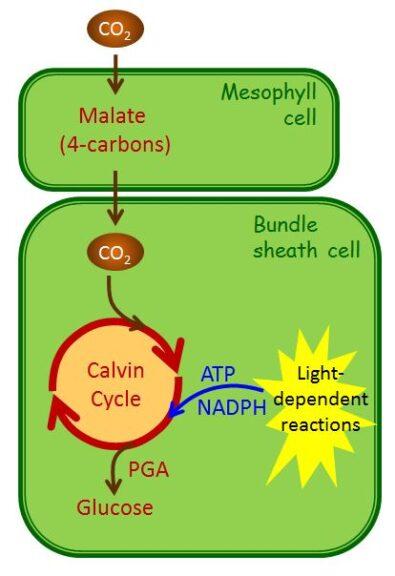
From the bundle sheath cells, ATP must be converted into the three-carbon “ferry” molecule and prepared for the next stage, which is to carry out another molecule of ambient carbon dioxide from the cell membrane. As a result of the ongoing pumping of carbon dioxide into adjacent bundle-sheath cells in the form of malate (malic acid), by the mesophyll cells, the level of carbon dioxide concentration remains high relative to oxygen, right around RuBisCO. Photorespiration is decreased as a consequence of this strategy.
About 3% of vascular plants use the C4 route; notable examples include sugarcane, crabgrass, and maize. While C4 plants can be found in abundance in hotter conditions, their numbers are dramatically reduced in cooler environments.
According to studies, if the temperature is high enough, the advantages of decreased photorespiration will very certainly balance the ATP cost of carbon dioxide transport from the mesophyll cell into the bundle-sheath cell. (Academy, 2022) Nevertheless, since C4 morphological and biochemical adaptations demand more energy and resources from the plant than C3 photosynthesis, wild-type C3 plants are usually more photosynthetically effective and efficient under colder conditions. (Modules, 2018)
However, since C4 plants tend to have higher photosynthetic performance because of having a C4 pathway in addition to the C3 pathway, especially in areas with high temperatures, modern research and technology in plant sciences have been employed to improve C3 plants’ photosynthetic performance. One of these strategies is to transfer the C4 traits to C3 plants. Through molecular or genetic engineering, important crops, such as rice and wheat, which are C3 plants could benefit from this. By recombinant DNA technology, the photosynthetic enzymes involved in the C4 pathway can be induced to express at high levels and in desired locations, for example by inducing cell-specific expression of photosynthetic genes in the bundle sheath of rice leaves. (Miyao, 2002) Predictive models implicate that rice yield could improve by generating C4 rice. (Hibberd et al., 2008)
C4 Plants Examples
Is maize a c4 plant? Yes, it is a C4 plant. In fact, many crops are, such as sugar cane, maize, millet, sorghum, and switchgrass. They are commonly found in warm to high-temperature environments. Southwest Asia and Central Asia have been cited as the origin of at least 20 of the 38 lineages of C4 Eudicots apart from the C4 Monocots. (Rudov et al., 2020)
Try to answer the quiz below to check what you have learned so far about C4 plants.
Reference
- Academy, K. (2022). C3, C4, and CAM plants. Retrieved 26 March, 2022, from https://www.khanacademy.org/science/biology/photosynthesis-in-plants#photorespiration–c3-c4-cam-plants
- Dobrijevic, D. (2021). What is photosynthesis. Retrieved 26 March, 2022, from https://www.livescience.com/51720-photosynthesis.html
- Edwards, G. E., Kiirats, O., Laisk, A., & Okita, T. W. (2000). Requirements for the CO2-concentrating mechanism in C4 plants relative to limitations on carbon assimilation in rice**Citation: Sheehy JE, Mitchell PL, Hardy B, editors. 2000. Redesigning rice photosynthesis to increase yield. Proceedings of the Workshop on The Quest to Reduce Hunger: Redesigning Rice Photosynthesis, 30Nov.-3 Dec. 1999. Los Baños. Philippines. Makati City (Philippines): International Rice Research Institute and Amsterdam (The Netherlands): Elsevier Science B.V. 293 p. Redesigning Rice Photosynthesis to Increase Yield, Proceedings of the Workshop on the Quest to Reduce Hunger: Redesigning Rice Photosynthesis, 99–112. https://doi.org/10.1016/s0928-3420(00)80009-9
- Hibberd, J. M., Sheehy, J. E., & Langdale, J. A. (2008). Using C4
photosynthesis to increase the yield of rice—rationale and feasibility. Current Opinion in Plant Biology, 11(2), 228–231. https://doi.org/10.1016/j.pbi.2007.11.002 - Kadereit, G., Ackerly, D., and Pirie, M.D. (2012). A broader model for C4 photosynthesis evolution in plants inferred from the goosefoot family (Chenopodiaceae s.s.). Proceedings of the Royal Society B: Biological Sciences. https://royalsocietypublishing.org/doi/10.1098/rspb.2012.0440
- Modules, I. (2018). C3 and C4 photosynthesis. Retrieved 26 March, 2022, from https://serc.carleton.edu/integrate/teaching_materials/food_supply/student_materials/1167#:~:text=Examples%20of%20C4%20plants%20include,more%20photosynthetically%20efficient%20and%20productive.
- Nakamura, N., Iwano, M., Havaux, M., Yokota, A., & Munekage, Y. N. (2013). Promotion of cyclic electron transport around photosystem I during the evolution of NADP-malic enzyme-type C4photosynthesis in the genusFlaveria. New Phytologist, 199(3), 832–842. https://doi.org/10.1111/nph.12296
- Nomura, M., Katayama, K., Nishimura, A., Ishida, Y., Ohta, S., Komari, T., Miyao-Tokutomi, M., Tajima, S., & Matsuoka, M. (2000). Plant Molecular Biology, 44(1), 99–106. https://doi.org/10.1023/a:1006461812053
- Rudov, A., Mashkour, M., Djamali, M., & Akhani, H. (2020). A Review of C4 Plants in Southwest Asia: An Ecological, Geographical and Taxonomical Analysis of a Region With High Diversity of C4 Eudicots. Frontiers in Plant Science, 11. https://doi.org/10.3389/fpls.2020.546518
- ScienceDaily. (2020). Successful improvement of the catalytic activity of photosynthetic CO2 fixing enzyme Rubisco. ScienceDaily. https://www.sciencedaily.com/releases/2020/09/200915090123.htm
- Topper. (2022). Difference between C3 and C4 Plant. Retrieved 26 March, 2022, from https://www.toppr.com/guides/biology/difference-between/c3-and-c4-plants/#:~:text=C3%20plants%20use%20the%20C3,the%20dark%20reaction%20of%20photosynthesis.&text=These%20plants%20are%20cool%2Dseason,commonly%20found%20in%20dry%20areas.
©BiologyOnline.com. Content provided and moderated by Biology Online Editors.


